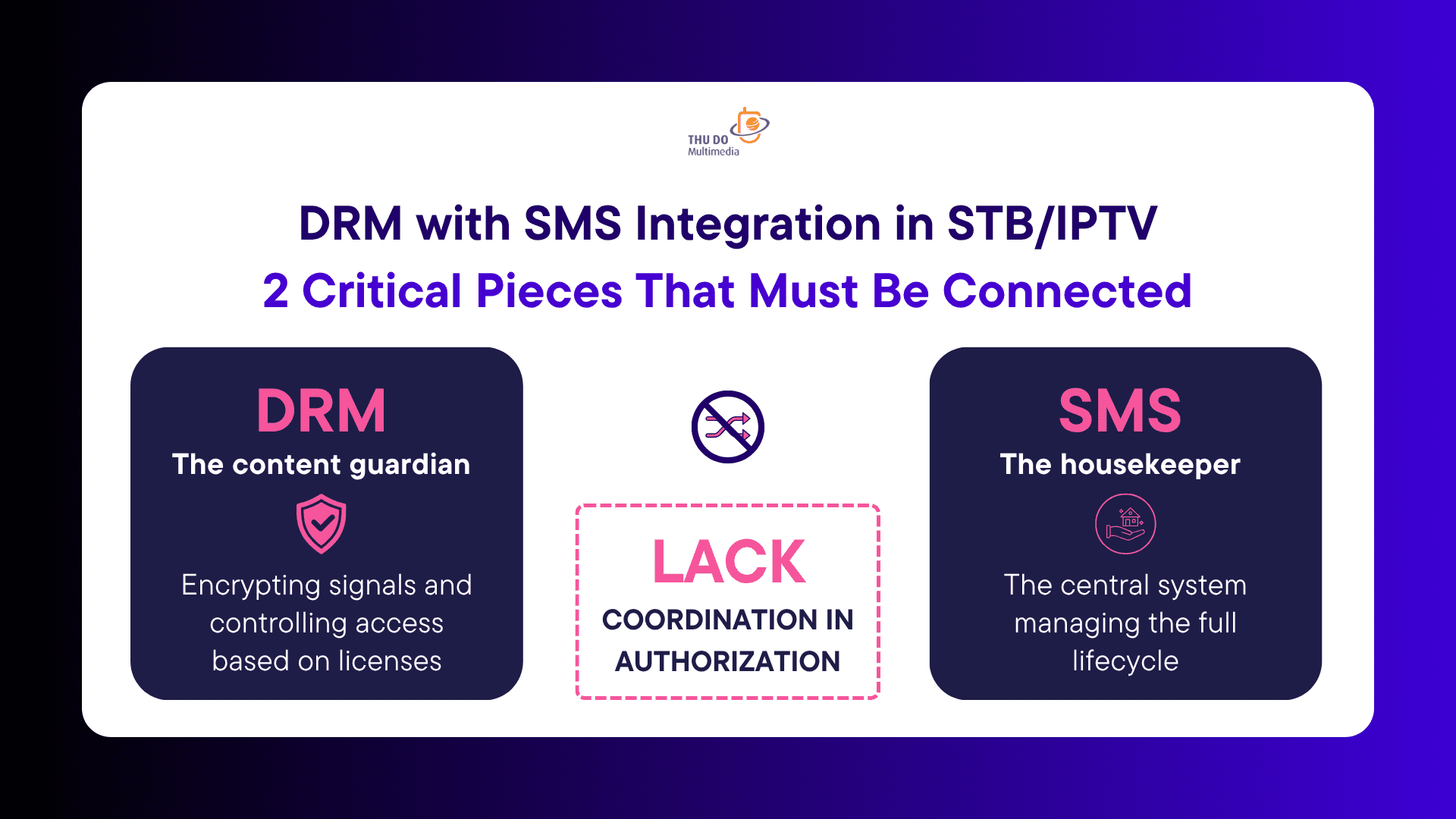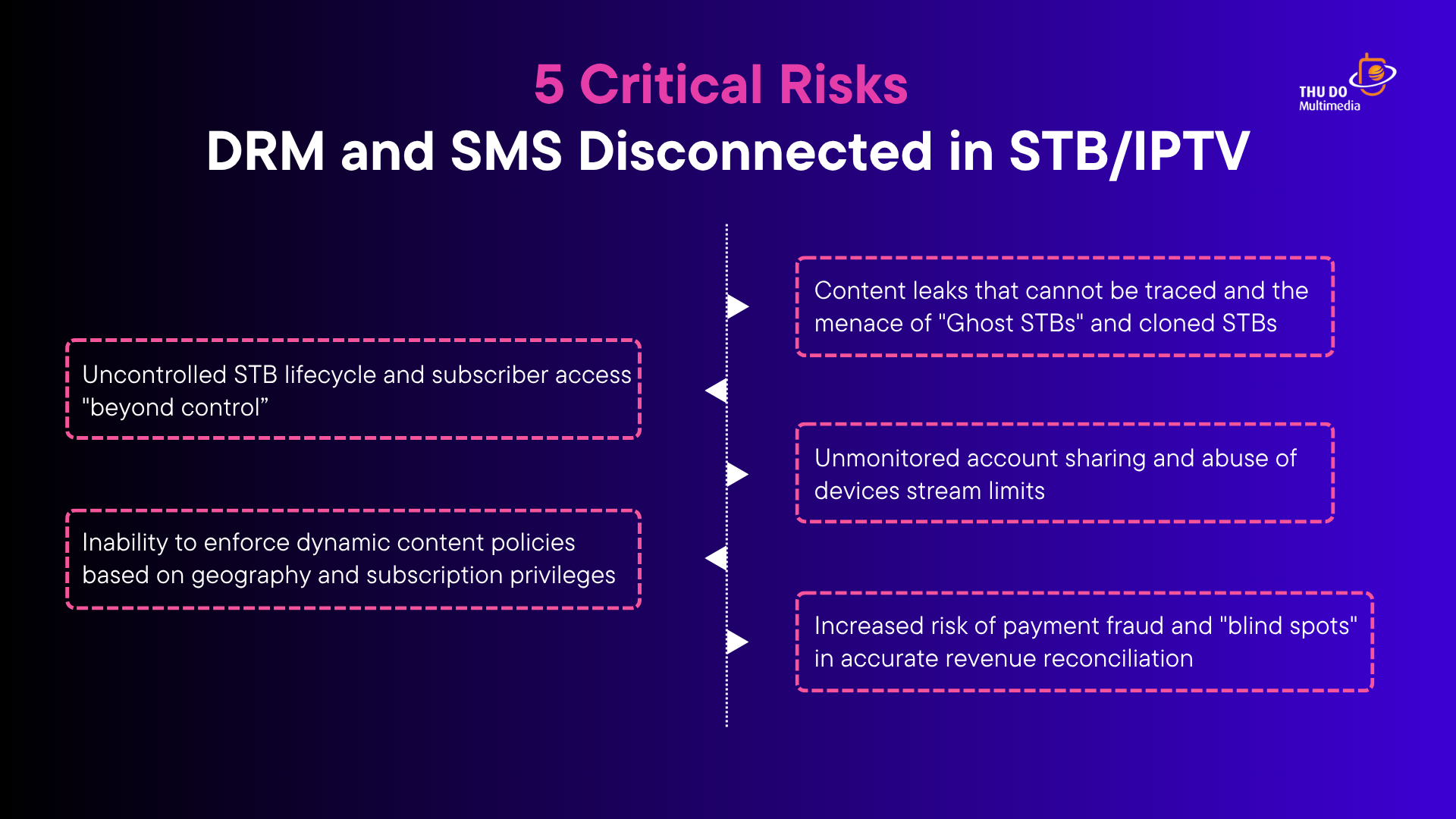DRM with SMS integration is essential for protecting your IPTV/STB system against critical risks, including revenue loss, content piracy, and unauthorized access. Without this integration, you expose your service to untraceable content leaks, uncontrolled subscriber access, and severe security vulnerabilities.
Your IPTV/STB system may be serving millions of subscribers, but are you truly in control of each individual set-top box? What happens if an STB is cloned, allowing unauthorized access to premium content without any traceability? Or when a long-expired subscriber continues to freely enjoy paid channels?
This is no longer hypothetical. These are real-world security gaps and revenue leakages that are challenging providers every day.
However, the absence of an intelligent orchestration layer, a tightly integrated, bidirectional bridge between the DRM and SMS systems, has become the Achilles’ heel of many operations. This missing link introduces serious vulnerabilities that impact security, operations, revenue, and the overall credibility of service providers.
DRM with SMS Integration in STB/IPTV: 2 Critical Pieces That Must Be Connected

DRM (Digital Rights Management) – “The content guardian” – is responsible for encrypting signals and controlling access based on licenses granted to each STB. Its mission: prevent unauthorized copying, recording, and redistribution of premium content.
SMS (Subscriber Management System) – “The housekeeper” – serves as the central system managing the full lifecycle of subscribers: from registration, subscription packages, and payment history to account status. It also oversees the lifecycle of every associated STB device.
So, the problem is: DRM knows what content must be protected but cannot verify whether the user is authorized. SMS knows who the legitimate subscribers are but cannot directly enforce access rights to content.
This lack of synchronization between the two systems creates critical security gaps, vulnerabilities that can be exploited by malicious actors.
A fully integrated system ensures that every content access request from a set-top box is verified not only by DRM, but also cross-checked against subscriber information from SMS. This dual-layer validation guarantees consistency and accuracy in enforcing the entitlements and status of every subscriber-STB pair.
5 Critical Risks When DRM with SMS Integration Are Disconnected in STB/IPTV
1. Content leaks that cannot be traced and the menace of “Ghost STBs” and cloned STBs
When the Digital Rights Management (DRM) system is not tightly connected to the Subscriber Management System (SMS), identifying the source of leaked content becomes impossible. Fake or cloned STBs can distribute unauthorized content without leaving any trace.
These cloned devices, often created using stolen credentials or duplicated device IDs, operate outside of the provider’s control. They can stream premium content without authorization, bypassing subscription fees and causing significant financial damage.
Consequently, there will be a significant revenue loss, violation of copyright agreements with content owners, and most critically, the inability to trace the violator for legal action.
2. Uncontrolled STB lifecycle and subscriber access “beyond control”
When the system cannot manage the lifecycle of each STB, expired subscribers can still access content. This occurs when STBs are not properly deactivated, or access licenses are not revoked.
In an ideal setup, SMS should automatically communicate with DRM to revoke access for expired subscriptions. However, without integration, STBs can remain active even after a subscriber cancels their contract
This leads to ongoing revenue losses due to expired subscribers who continue accessing content, along with heightened security risks from unauthorized STBs.
3. Unmonitored account sharing and abuse of devices stream limits
Users can share accounts with multiple others without the provider’s knowledge, making device and stream limits meaningless. This is especially common when subscribers share login credentials with friends or family members.
Without DRM and SMS integration, the provider cannot detect abnormal usage patterns, such as a single account being used simultaneously on multiple devices.
As a result, significant financial losses occur as multiple users share a single account, leading to system congestion and a decline in service quality for legitimate subscribers.
4. Inability to enforce dynamic content policies based on geography and subscription privileges
Due to a lack of synchronization between DRM and SMS, providers cannot enforce content distribution policies based on geographical location, subscription tiers, or user privileges.
For instance, a subscriber with a basic package might gain access to premium channels, or users in restricted regions might bypass geo-blocking.
Copyright violations and loss of broadcasting rights in exclusive regions, resulting in reduced revenue and damage to brand reputation.
5. Increased risk of payment fraud and “blind spots” in accurate revenue reconciliation
A lack of synchronization between DRM and SMS leads to errors in revenue recording, making it impossible to detect and control payment fraud.
This can manifest as incorrect billing, unauthorized Pay-Per-View (PPV) access, or even cases where subscribers continue to be charged after canceling.
Unexplained revenue loss leads to financial reconciliation challenges, triggering customer complaints and ultimately damaging provider credibility.
Common Pitfalls to Avoid When Implementing DRM-SMS Integration
1. Superficial integration: Settling for basic API connections
Many providers make the mistake of considering basic API connections as sufficient for integration. However, without deep integration that enables real-time data exchange, critical information may not sync between DRM and SMS, leaving security gaps.
2. Neglecting data mapping and standardization
Poorly mapped data between DRM and SMS can lead to inconsistencies, such as unauthorized devices gaining access or legitimate subscribers being denied content. Ensure all subscriber information, device data, and access rights are clearly mapped.
3. Lack of a comprehensive testing plan
Failing to conduct thorough testing across all possible scenarios can result in unexpected errors post-launch. Create a detailed testing plan covering functional, performance, and security aspects in a controlled environment (UAT).
In order to create an effective testing plan, it is important to have certain aims and KPIs for the team.
Read more: 5 KPIs for CTOs When Deploying a DRM Integrated with SMS
4. Overlooking scalability and future-proofing
Your DRM-SMS integration should not only meet current needs but also be scalable for future expansion. Neglecting this can result in costly upgrades later.
5. Ignoring security and compliance requirements
Failing to implement strong encryption, access control, and compliance with regional data protection regulations can expose your system to legal and security risks.
Integrating DRM with the Subscriber Management System (SMS) is not just a technological task – it’s a strategic move. For a step by step roadmap to help IPTV providers in India stay on track, avoid pitfalls, and maximize efficiency, you can read more: Roadmap to Tackle IPTV Piracy at Its Root in India 2025
In a rapidly evolving STB/IPTV landscape, disconnected DRM and SMS systems are a ticking time bomb. The risks of untraceable content leaks, uncontrolled subscriber access, and payment fraud are real and growing:
- Content leaks that cannot be traced and the menace of “Ghost STBs” and cloned STBs
- Uncontrolled STB lifecycle and subscriber access “beyond control”
- Unmonitored account sharing and abuse of devices stream limits
- Inability to enforce dynamic content policies based on geography and subscription privileges
- Increased risk of payment fraud and “blind spots” in accurate revenue reconciliation
A fully integrated DRM-SMS solution transforms your system from vulnerable to secure, from chaotic to controlled. By ensuring that every content access is verified and synchronized between DRM and SMS, you gain complete visibility, protect your revenue, and deliver a premium experience to your subscribers.
Ready to secure your content and maximize your revenue? Schedule a demo today and discover how a fully integrated DRM-SMS solution can protect your service and elevate your business.


Recent Comments